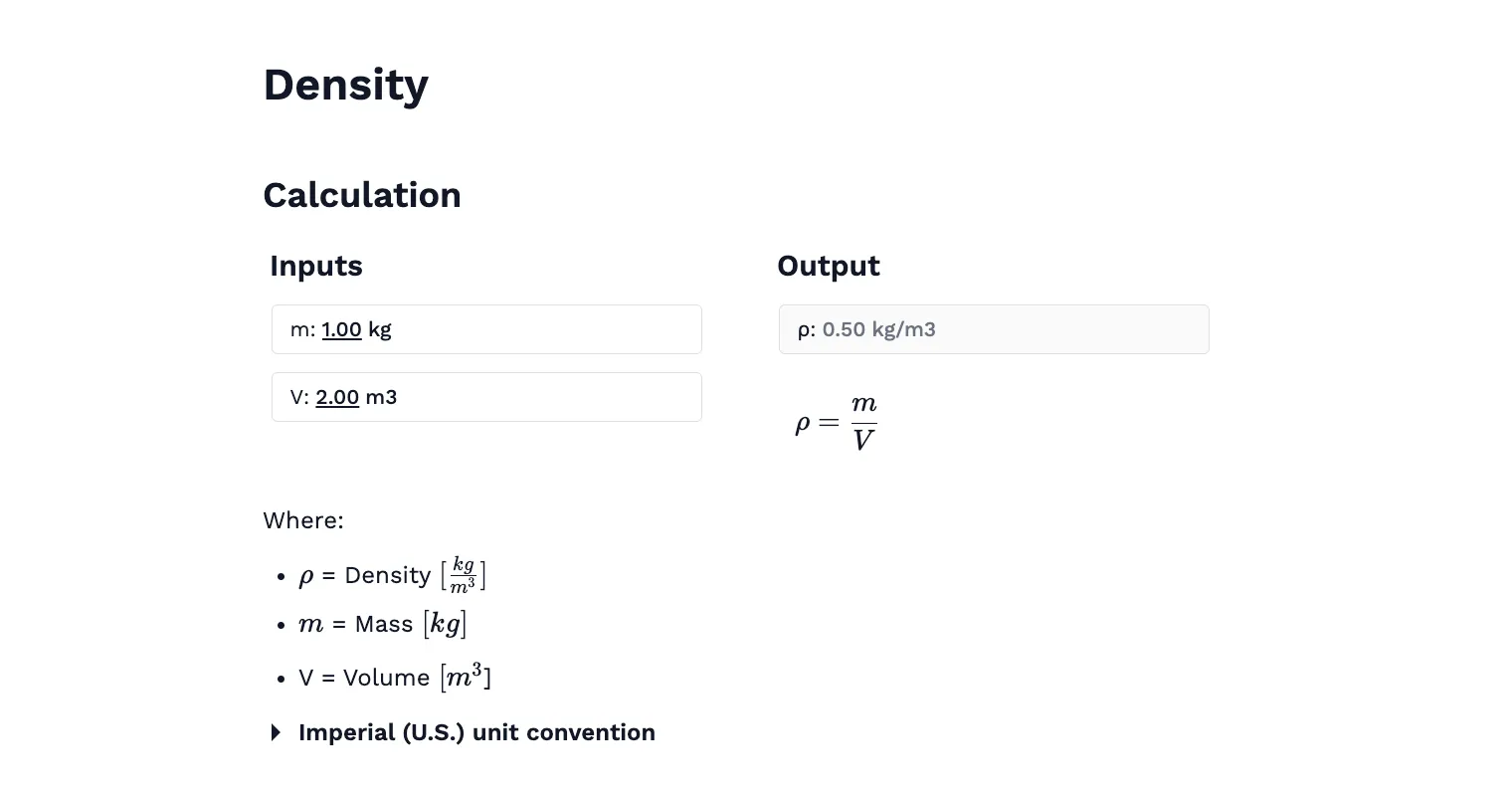Free Density, Specific Weight and Specific Gravity Calculator. Step-by-step, engineering-grade tool with downloadable report.

This template is not available yet. You can sign up and create it yourself!
Or let us know if you'd like to be notified when it’s ready:
This Density, Specific Weight Calculator, and Specific Gravity Calculator is a practical and reliable tool designed to help engineers and technical professionals quickly determine key material properties essential to mechanical, civil, and fluid system analysis.
Density is defined as mass per unit volume \(ρ = m/V\) and is foundational in evaluating how substances behave under different physical conditions. Specific weight (γ), on the other hand, is the weight of a material per unit volume and is calculated using the formula: \(γ = ρ × g\).
Where:
- \(ρ\) is the material’s density, and
- \(g\) is the local gravitational acceleration (typically 9.81 m/s²)
Specific weight is expressed in units such as \(N/m³\) (SI) or \(lb/ft³\) (imperial), and it’s commonly used in engineering applications involving pressure, buoyancy, and fluid statics.
Specific gravity (also referred to as relative density) is a dimensionless value that compares the density of a material to the density of water. It’s given by the formula: \(specific gravity = water density/material density\) and is often used in both fluid mechanics and material science to assess buoyancy and material classification. Note that accurate measurement of specific gravity depends on temperature, since fluid density varies with thermal conditions.
This calculator is for:
- Mechanical Engineers: Evaluate material behavior under load, assist with pump and fluid system design, and ensure appropriate material selection for dynamic systems.
- Civil Engineers: Analyse soil and construction material properties, assess hydrostatic forces in retaining walls and foundations, and support geotechnical design.
- Students and Educators: Explore and understand the relationships between density, specific weight, and specific gravity in real-world and theoretical contexts.
This Density, Specific Weight and Specific Gravity tool allows for quick checks and validations, simplifying the process of analyzing material and fluid behavior. The calculator requires only basic input values to perform calculations. The calculator can also convert between SI and imperial units for specific weight and density. To dive deeper into these concepts, refer to textbooks such as Fundamentals of Fluid Mechanics by Munson et al. or Introduction to Materials Science for Engineers by James F. Shackelford.
Engineering templates
Common calculators
Design guides
FAQs
What is density?
Density is the mass of a material per unit volume. It is a fundamental property used to describe how compact or heavy a material is. In scientific formulas, density is represented by the Greek letter 'rho' (\(ρ\)). Accurate measuring of mass and volume is essential for precise density calculations.
How does specific weight differ from density?
The difference between specific weight and density is that specific weight refers to the weight of a material per unit volume, taking into account gravitational force, while density is purely a mass-to-volume ratio. This difference is important in engineering calculations, as it affects how materials behave under varying gravitational conditions.
The weight equation, \(W = mg\), is fundamental in physics for calculating the weight of an object by multiplying its mass by the acceleration due to gravity. This equation is based on Newton's second law of motion, which relates force, mass, and acceleration.
Can these properties vary with temperature and pressure?
Yes, density, specific weight, and specific gravity can change with temperature and pressure, particularly in fluids and gases, where these variations are more pronounced. Changes in temperature and pressure can affect the measurement of these properties over time and at different lengths or scales, making dimensional analysis important for accurate calculations.
When reporting results affected by temperature and pressure variations, it is essential to use the correct number of significant figures to ensure precision and reliability in scientific and engineering contexts.
Properties of Common Materials
Understanding the properties of common materials is crucial in engineering, construction, and scientific research. Key properties such as density, specific weight, and specific gravity help engineers and scientists determine how materials will behave under different conditions, making accurate calculation and measurement essential.
Density is defined as mass per unit volume and is typically measured in kilograms per cubic meter (\(kg/m³\)) in the SI unit system. The formula for density is straightforward: \(Density = Mass / Volume\). This calculation allows you to find how much mass is packed into a given space, which is important when comparing materials or selecting the right material for a specific application.
To determine the specific weight of a material, you multiply its density by the gravitational force (usually 9.80665 \(m/s²\)). The result, represents the weight per unit volume and is a crucial value in engineering, especially when calculating the weight of objects and the forces they exert. For example, steel—a common engineering material—has a density of about 7850 \(kg/m³\). The specific weight of steel is approximately 76950 \(N/m³\). This result is important for engineers when designing structures, as it helps them calculate the total weight and the forces involved.
Specific gravity is another important property, defined as the ratio of the density of a substance to the density of water (which is set as the reference and equal to 1). The formula is: \(Specific Gravity = Density of Substance / Density of Water\). For example, water has a specific gravity of 1, while steel, with a much higher density, has a specific gravity of about 7.85. This ratio is commonly used to compare materials and understand how heavy or light a substance is relative to water.
Other common materials, such as concrete, have their own unique properties. Concrete typically has a density around 2400 \(kg/m³\), and its specific weight is a critical factor in construction engineering, affecting the design and safety of buildings and infrastructure.
Using tools like a weight calculator or density calculator makes it easy for people to find and check these values, explore different materials, and understand how changes in mass, volume, or gravitational force affect the results. Whether you’re working with fluids, solids, or gases, having a solid grasp of these properties and the formulas used to calculate them is essential for reliable engineering and scientific outcomes.
In summary, the ability to calculate and understand the density, specific weight, and specific gravity of common materials is fundamental in engineering and science. By using the correct formulas, units, and tools, you can ensure your measurements and results are accurate, helping you make informed decisions in any project or research involving material properties.
Learn about the benefits of using CalcTree on engineering projects!


